APA Format for Students & Researchers
Дата публікації: 14.11.2022
Автори: Відкриті джерела
Ключові слова: APA, guide, research, properly formatted
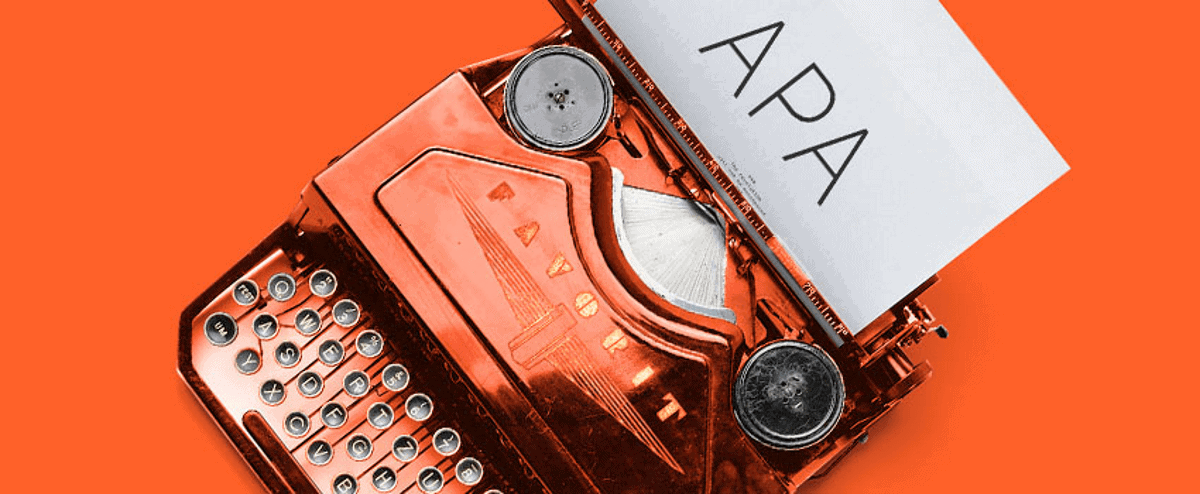
In this guide, students and researchers can learn the basics of creating a properly formatted research paper according to APA guidelines.
It includes information on how to conceptualize, outline, and format the basic structure of your paper, as well as practical tips on spelling, abbreviation, punctuation, and more. The guide concludes with a complete sample paper as well as a final checklist that writers can use to prepare their work for submission.
APA Paper Formatting Basics
- All text should be double-spaced
- Use one-inch margins on all sides
- All paragraphs in the body are indented
- Make sure that the title is centered on the page with your name and school/institution underneath
- Use 12-point font throughout
- All pages should be numbered in the upper right hand corner
- The manual recommends using one space after most punctuation marks
- A shortened version of the title (“running head”) should be placed in the upper left hand corner
Information related to writing and organizing your paper:
- Paper and essay categories
- General paper length
- Margin sizes
- Title pages
- Running Heads
- APA Outline
- APA Abstract
- The body of papers
- APA headings and subheadings
- Use of graphics (tables and figures)
Writing style tips:
- Verb usage
- Proper tone
- Reducing bias and labels
- Spelling
- Abbreviation do’s and don’ts
- Spacing
- Punctuation
- Number rules
Citing Your Sources:
- Citing Sources
- In-text Citations
- Reference Page
Proofing Your Paper:
- Final checklist
- Submitting your project
APA Information:
- What is APA
- APA 7 Updates
What you won’t find in this guide: This guide provides information related to the formatting of your paper, as in guidelines related to spacing, margins, word choice, etc. While it provides a general overview of APA references, it does not provide instructions for how to cite in APA format.
For step-by-step instructions for citing books, journals, how to cite a website in APA format, information on an APA format bibliography, and more, refer to these other EasyBib guides:
- APA citation (general reference guide)
- APA In-text citation
- APA article citation
- APA book citation
- APA citation website
Or, you can use our automatic generator. Our APA formatter helps to build your references for you. Yep, you read that correctly.
Writing and Organizing Your APA Paper in an Effective Way
This section of our guide focuses on proper paper length, how to format headings, spacing, and more! This information can be found in Chapter 2 of the official manual (American Psychological Association, 2020, pp. 29-67).
Categories of papers
Before getting into the nitty-gritty details related to APA research paper format, first determine the type of paper you’re about to embark on creating:
Empirical studies
Empirical studies take data from observations and experiments to generate research reports. It is different from other types of studies in that it isn’t based on theories or ideas, but on actual data.
Literature reviews
These papers analyze another individual’s work or a group of works. The purpose is to gather information about a current issue or problem and to communicate where we are today. It sheds light on issues and attempts to fill those gaps with suggestions for future research and methods.
Theoretical articles
These papers are somewhat similar to a literature reviews in that the author collects, examines, and shares information about a current issue or problem, by using others’ research. It is different from literature reviews in that it attempts to explain or solve a problem by coming up with a new theory. This theory is justified with valid evidence.
Methodological articles
These articles showcase new advances, or modifications to an existing practice, in a scientific method or procedure. The author has data or documentation to prove that their new method, or improvement to a method, is valid. Plenty of evidence is included in this type of article. In addition, the author explains the current method being used in addition to their own findings, in order to allow the reader to understand and modify their own current practices.
Case studies
Case studies present information related an individual, group, or larger set of individuals. These subjects are analyzed for a specific reason and the author reports on the method and conclusions from their study. The author may also make suggestions for future research, create possible theories, and/or determine a solution to a problem.
General paper length
Since APA style format is used often in science fields, the belief is “less is more.” Make sure you’re able to get your points across in a clear and brief way. Be direct, clear, and professional. Try not to add fluff and unnecessary details into your paper or writing. This will keep the paper length shorter and more concise.
Margin sizes in APA Format
When it comes to margins, keep them consistent across the left, right, top, and bottom of the page. All four sides should be the same distance from the edge of the paper. It’s recommended to use at least one-inch margins around each side. It’s acceptable to use larger margins, but the margins should never be smaller than an inch.
Title pages in APA Format
The title page, or APA format cover page, is the first page of a paper or essay. Some teachers and professors do not require a title page, but some do. If you’re not sure if you should include one or not, ask your teacher. Some appreciate the page, which clearly displays the writer’s name and the title of the paper.
The APA format title page for student papers includes six main components:
- the title of the APA format paper
- names of all authors
- institutional affiliation
- course number and title
- instructor’s name
- due date
Title pages for professional papers also require a running head; student papers do not.
Some instructors and professional publications also ask for an author’s note. If you’re required or would like to include an author’s note, place it below the institutional affiliation. Examples of information included in an author’s note include an ORCID iD number, a disclosure, and an acknowledgement.
Here are key guidelines to developing your title page:
- The title of the paper should capture the main idea of the essay, but should not contain abbreviations or words that serve no purpose. For example, instead of using the title “A Look at Amphibians From the Past,” title the paper “Amphibians From the Past.” Delete the unnecessary fluff!
- Center the title on the page and place it about 3-4 lines from the top.
- The title should be bolded, in title case, and the same font size as your other page text. Do not underline or italicize the title. Other text on the page should be plain (not bolded, underlined, or italicized).
- All text on the title page should be double-spaced. The APA format examples paper below displays proper spacing, so go take a look!
- Do not include any titles in the author’s name such as Dr. or Ms. In contrast, for your instructor’s name, use the form they prefer (e.g., Sagar Parekh, PhD; Dr. Minako Asato; Professor Nathan Ian Brown; etc.).
- The institutional affiliation is the school the author attends or the location where the author conducted the research.
Sample of an APA format title page for a student paper:

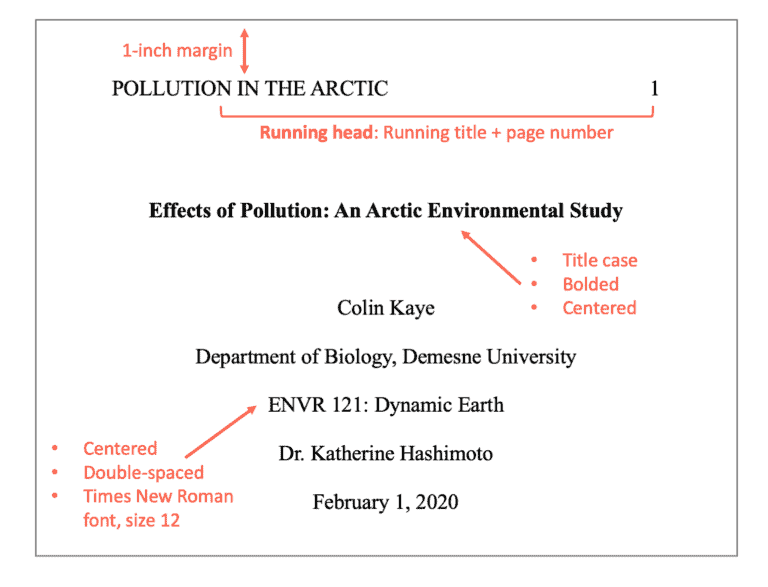
Running heads in APA Format
The 7th edition of the American Psychological Association Publication Manual (p. 37) states that running heads are not required for student papers unless requested by the instructor. Student papers still need a page number included in the upper right-hand corner of every page. The 6th edition required a running head for student papers, so be sure to confirm with your instructor which edition you should follow. Of note, this guide follows the 7th edition.
Running heads are required for professional papers (e.g., manuscripts submitted for publication). Read on for instructions on how to create them.
Are you wondering what is a “running head”? It’s basically a page header at the top of every page. To make this process easier, set your word processor to automatically add these components onto each page. You may want to look for “Header” in the features.
A running head/page header includes two pieces:
- the title of the paper
- page numbers.
Insert page numbers justified to the right-hand side of the APA format paper (do not put p. or pg. in front of the page numbers).
For all pages of the paper, including the APA format title page, include the “TITLE OF YOUR PAPER” justified to the left in capital letters (i.e., the running head). If your full title is long (over 50 characters), the running head title should be a shortened version.

Preparing outlines in APA Format
Outlines are extremely beneficial as they help writers stay organized, determine the scope of the research that needs to be included, and establish headings and subheadings.
There isn’t an official or recommended “APA format for outline” structure. It is up to the writer (if they choose to make use of an outline) to determine how to organize it and the characters to include. Some writers use a mix of roman numerals, numbers, and uppercase and lowercase letters.
Even though there isn’t a required or recommended APA format for an outline, we encourage writers to make use of one. Who wouldn’t want to put together a rough outline of their project? We promise you, an outline will help you stay on track.
Here’s our version of how APA format for outlines could look:
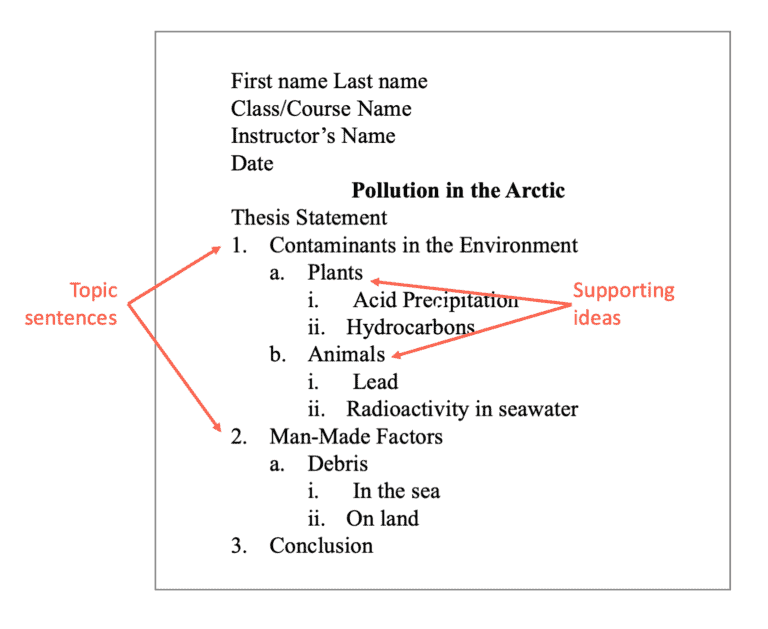
Don’t forget, if you’re looking for information on APA citation format and other related topics, check out our other comprehensive guides.
How to form an abstract in APA
An APA format abstract (p. 38) is a summary of a scholarly article or scientific study. Scholarly articles and studies are rather lengthy documents, and abstracts allow readers to first determine if they’d like to read an article in its entirety or not.
You may come across abstracts while researching a topic. Many databases display abstracts in the search results and often display them before showing the full text of an article or scientific study. It is important to create a high quality abstract that accurately communicates the purpose and goal of your paper, as readers will determine if it is worthy to continue reading or not.
Are you wondering if you need to create an abstract for your assignment?Usually, student papers do not require an abstract. Abstracts are not typically seen in class assignments, and are usually only included when submitting a paper for publication. Unless your teacher or professor asked for it, you probably don’t need to have one for your class assignment.
If you’re planning on submitting your paper to a journal for publication, first check the journal’s website to learn about abstract and APA paper format requirements.
Here are some helpful suggestions to create a dynamic abstract:
- Abstracts are found on their own page, directly after the title or cover page.
- Professional papers only (not student papers): Include the running head on the top of the page.
- On the first line of the page, center the word “Abstract” (but do not include quotation marks).
- On the following line, write a summary of the key points of your research. Your abstract summary is a way to introduce readers to your research topic, the questions that will be answered, the process you took, and any findings or conclusions you drew. Use concise, brief, informative language. You only have a few sentences to share the summary of your entire document, so be direct with your wording.
- This summary should not be indented, but should be double-spaced and less than 250 words.
- If applicable, help researchers find your work in databases by listing keywords from your paper after your summary. To do this, indent and type Keywords: in italics. Then list your keywords that stand out in your research. You can also include keyword strings that you think readers will type into the search box.
- Use an active voice, not a passive voice. When writing with an active voice, the subject performs the action. When writing with a passive voice, the subject receives the action.
- Active voice: The subjects reacted to the medication.
- Passive voice: There was a reaction from the subjects taking the medication.
- Instead of evaluating your project in the abstract, simply report what it contains.
- If a large portion of your work includes the extension of someone else’s research, share this in the abstract and include the author’s last name and the year their work was released.
APA format example page:
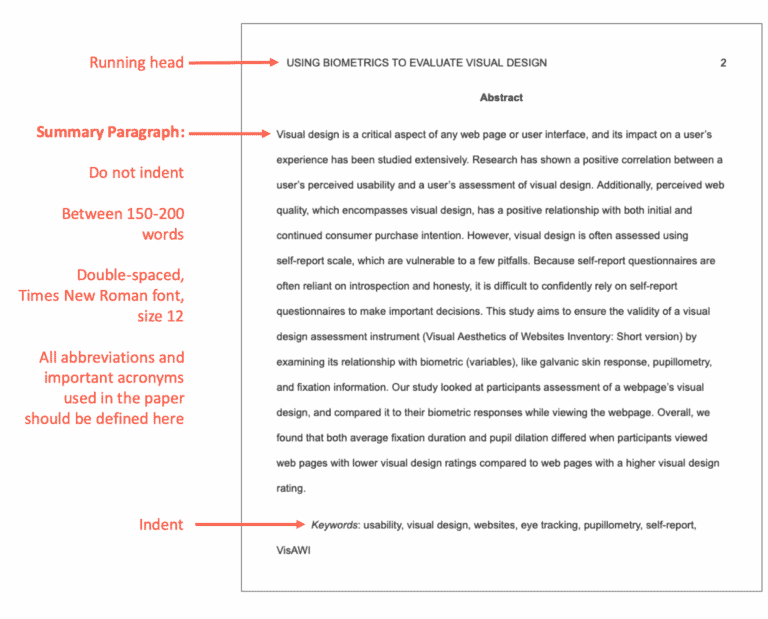
Here’s an example of an abstract:
Visual design is a critical aspect of any web page or user interface, and its impact on a user’s experience has been studied extensively. Research has shown a positive correlation between a user’s perceived usability and a user’s assessment of visual design. Additionally, perceived web quality, which encompasses visual design, has a positive relationship with both initial and continued consumer purchase intention. However, visual design is often assessed using self-report scale, which are vulnerable to a few pitfalls. Because self-report questionnaires are often reliant on introspection and honesty, it is difficult to confidently rely on self-report questionnaires to make important decisions. This study aims to ensure the validity of a visual design assessment instrument (Visual Aesthetics of Websites Inventory: Short version) by examining its relationship with biometric (variables), like galvanic skin response, pupillometry, and fixation information. Our study looked at participants assessment of a webpage’s visual design, and compared it to their biometric responses while viewing the webpage. Overall, we found that both average fixation duration and pupil dilation differed when participants viewed web pages with lower visual design ratings compared to web pages with a higher visual design rating.
Keywords: usability, visual design, websites, eye tracking, pupillometry, self-report, VisAWI
The body of an APA paper
On the page after the title page (if a student paper) or the abstract (if a professional paper), begin with the body of the paper.
Most papers follow this format:
- At the top of the page, add the page number in the upper right corner of all pages, including the title page.
- On the next line write the title in bold font and center it. Do not underline or italicize it.
- Begin with the introduction and indent the first line of the paragraph. All paragraphs in the body are indented.
Sample body for a student paper:
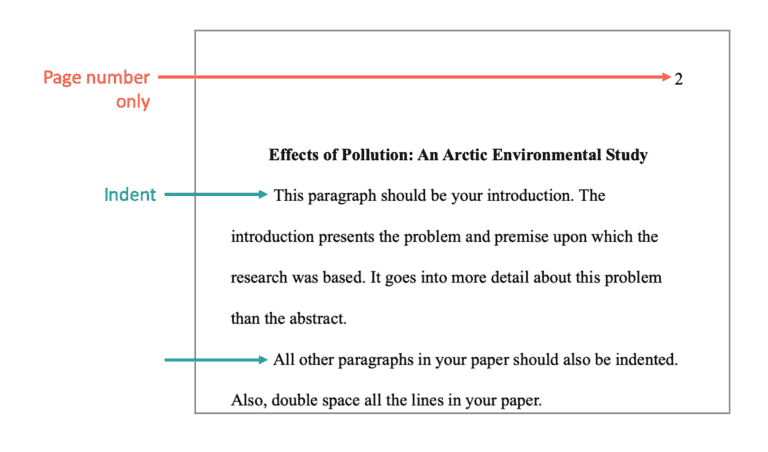
Most scientific or professional papers have additional sections and guidelines:
- Start with the running head (title + page number). The heading title should be in capital letters. The abstract page should be page 2.
- The introduction presents the problem and premise upon which the research was based. It goes into more detail about this problem than the abstract.
- Begin a new section with the Method and use this word as the subtitle. Bold and center this subtitle. The Method section shows how the study was run and conducted. Be sure to describe the methods through which data was collected.
- Begin a new section with the Results. Bold and center this subtitle. The Results section summarizes your data. Use charts and graphs to display this data.
- Begin a new section with the Discussion. Bold and center this subtitle. This Discussion section is a chance to analyze and interpret your results.
- Draw conclusions and support how your data led to these conclusions.
- Discuss whether or not your hypothesis was confirmed or not supported by your results.
- Determine the limitations of the study and next steps to improve research for future studies.
Sample body for a professional paper:
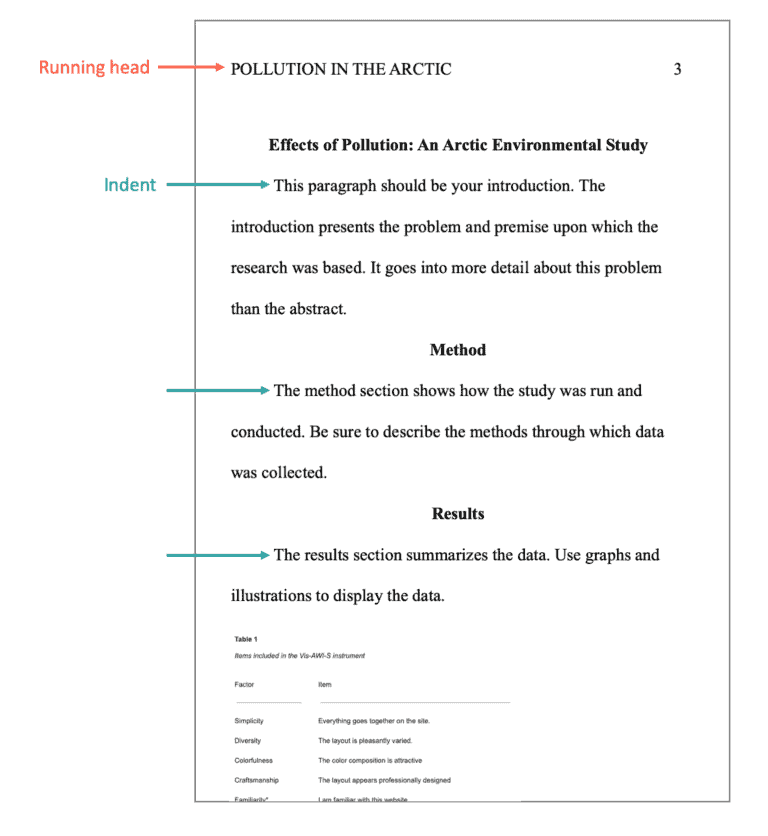
Proper usage of headings & subheadings in APA Format
Headings (p. 47) serve an important purpose in research papers — they organize your paper and make it simple to locate different pieces of information. In addition, headings provide readers with a glimpse to the main idea, or content, they are about to read.
In APA format, there are five levels of headings, each with a different formatting:
- Level 1:
- This is the title of your paper
- The title should be centered in the middle of the page
- The title should be bolded
- Use uppercase and lowercase letters where necessary (called title capitalization)
- Level 2:
- Place this heading against the left margin
- Use bold letters
- Use uppercase and lowercase letters where necessary
- Level 3:
- Place this heading against the left side margin
- Use bold letters
- Use uppercase and lowercase letters where necessary
- End the heading with a period
- Level 4:
- Indented in from the left margin
- Bolded
- Use uppercase and lowercase letters where necessary
- End the heading with a period
- Level 5:
- Indented
- Bolded
- Italicized
- Use uppercase and lowercase letters where necessary
- End the heading with a period
Following general formatting rules, all headings are double spaced and there are no extra lines or spaces between sections.
Here is a visual APA format template for levels of headings:
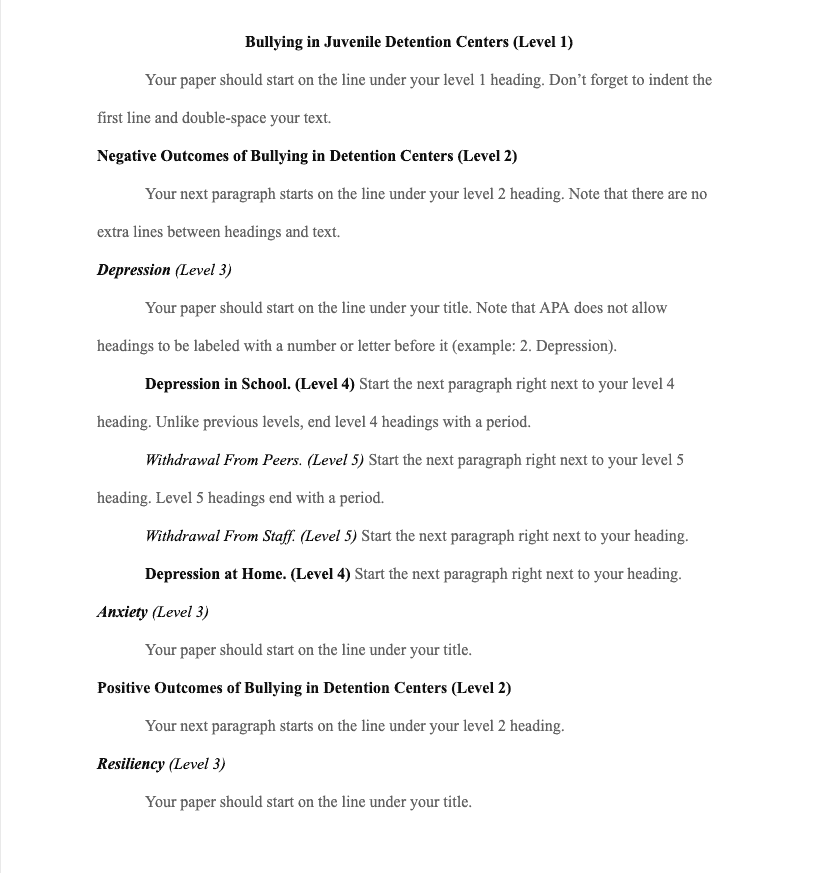
Use of graphics (tables and figures) in APA Format
If you’re looking to jazz up your project with any charts, tables, drawings, or images, there are certain APA format rules (pp. 195-250) to follow.
First and foremost, the only reason why any graphics should be added is to provide the reader with an easier way to see or read information, rather than typing it all out in the text.
Lots of numbers to discuss? Try organizing your information into a chart or table. Pie charts, bar graphs, coordinate planes, and line graphs are just a few ways to show numerical data, relationships between numbers, and many other types of information.
Instead of typing out long, drawn out descriptions, create a drawing or image. Many visual learners would appreciate the ability to look at an image to make sense of information.
Before you go ahead and place that graphic in your paper, here are a few key guidelines:
- All graphics, whether they’re tables, photographs, or drawings must be numbered. The first graphic, labeled as 1, should be the first one mentioned in the text.
- Follow them in the appropriate numerical order in which they appear in the text of your paper. Example: Figure 1, Figure 2, Table 1, Figure 3.
- Example: Figure 1, Figure 2, Table 1, Figure 3
- Only use graphics if they will supplement the material in your text. If they reinstate what you already have in your text, then it is not necessary to include a graphic.
- Include enough wording in the graphic so that the reader is able to understand its meaning, even if it is isolated from the corresponding text. However, do not go overboard with adding a ton of wording in your graphic.
- Left align tables and figures
In our APA format sample paper, you’ll find examples of tables after the references. You may also place tables and figures within the text just after it is mentioned.
Tables:
Is there anything better than seeing a neatly organized data table? We think not! If you have tons of numbers or data to share, consider creating a table instead of typing out a wordy paragraph. Tables are pretty easy to whip up on Google Docs or Microsoft Word.
General format of a table should be:
- Table number
- Title
- Table
- Note
- Here are a few pointers to keep in mind:
- Choose to type out your data OR create a table. As stated above, in APA format, you shouldn’t have the information typed out in your paper and also have a table showing the same exact information. Choose one or the other.
- If you choose to create a table, discuss it very briefly in the text. Say something along the lines of, “Table 1 displays the amount of money used towards fighting Malaria.” Or, “Stomach cancer rates are displayed in Table 4.”
- If you’re submitting your project for a class, place your table close to the text where it’s mentioned. If you’re submitting it to be published in a journal, most publishers prefer tables to be placed in the back. If you’re unsure where to place your tables, ask!
- Numbers & Title:
- Include the table number first and at the top. Table 1 is the first table discussed in the paper. Table 2 is the next table mentioned, and so on. This should be in bold.
- Add a title under the number. Create a brief, descriptive title. Capitalize the first letter for each important word. Italicize the title and place it under the table number.
- Formatting:
- Only use horizontal lines.
- Limit use of cell shading.
- Keep the font at 12-point size and use single or double spacing. If you use single spacing in one table, make sure all of the others use single spaces as well. Keep it consistent.
- All headings should be centered.
- In the first column (called the stub), center the heading, left-align the information underneath it (indent 0.15 inches if info is more than one line).
- Information in other columns should be centered.
- Note: If you need to further explain something, or include an APA format citation, place it in a note below the table. There are 3 types:
- General. Information about the whole table.
- Specific. Information targeted for a specific column, row, or cell.
- Probability. Explains what certain table symbols mean. For example, asterisks, p values, etc.
Here’s an APA format example of a table:
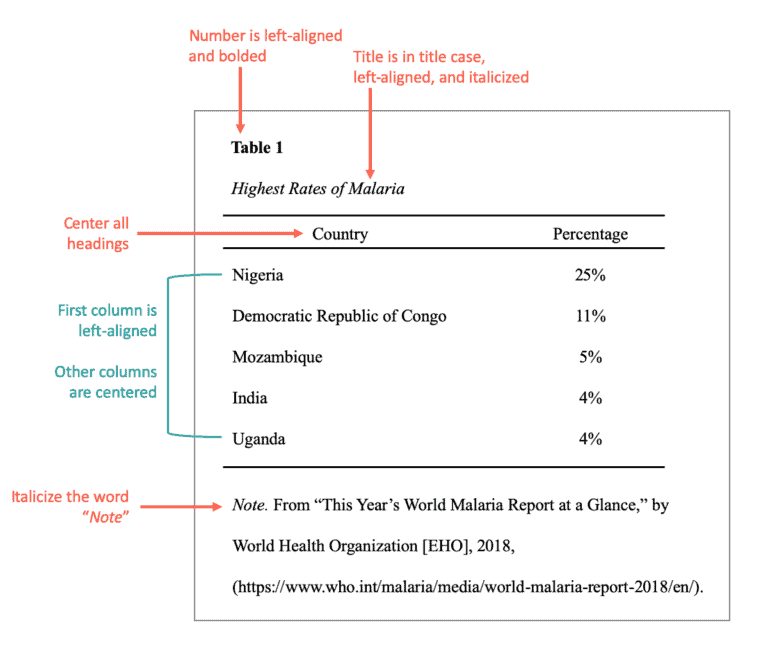
We know putting together a table is pretty tricky. That’s why we’ve included not one, but a few tables on this page. Scroll down and look at the additional tables in the essay in APA format example found below.
Figures:
Figures represent information in a visual way. They differ from tables in that they are visually appealing. Sure, tables, like the one above, can be visually appealing, but it’s the color, circles, arrows, boxes, or icons included that make a figure a “figure.”
There are many commonly used figures in papers. Examples APA Format:
- Pie charts
- Photographs
- Maps
- Hierarchy charts
- Drawings
General format of a figure is the same as tables. This means each should include:
- Figure number
- Title
- Figure
- Note
Use the same formatting tables use for the number, title, and note.
Here are some pointers to keep in mind when it comes to APA format for figures:
- Only include a figure if it adds value to your paper. If it will truly help with understanding, include it!
- Either include a figure OR write it all out in the text. Do not include the same information twice.
- If a note is added, it should clearly explain the content of the figure. Include any reference information if it’s reproduced or adapted.
APA format sample of a figure:

Photographs:
We live in a world where we have tons of photographs available at our fingertips.
Photographs found through Google Images, social media, stock photos made available from subscription sites, and tons of other various online sources make obtaining photographs a breeze. We can even pull out our cell phones, and in just a few seconds, take pictures with our cameras.
Photographs are simple to find, and because of this, many students enjoy using them in their papers.
If you have a photograph you would like to include in your project, here are some guidelines from the American Psychological Association.
- Create a reference for the photograph. Follow the guidelines under the table and figure sections above.
- Do not use color photos. It is recommended to use black and white. Colors can change depending on the reader’s screen resolution. Using black and white ensures the reader will be able to view the image clearly. The only time it is recommended to use color photos is if you’re writing about color-specific things. For example, if you’re discussing the various shades of leaf coloration, you may want to include a few photographs of colorful leaves.
- If there are sections of the photograph that are not related to your work, it is acceptable to crop them out. Cropping is also beneficial in that it helps the reader focus on the main item you’re discussing.
- If you choose to include an image of a person you know, it would be respectful if you ask their permission before automatically including their photo in your paper. Some schools and universities post research papers online and some people prefer that their photos and information stay off the Internet.
B. Writing Style Tips
Writing a paper for scientific topics is much different than writing for English, literature, and other composition classes. Science papers are much more direct, clear, and concise. This section includes key suggestions, explains how to write in APA format, and includes other tidbits to keep in mind while formulating your research paper.
Verb usage in APA
Research experiments and observations rely on the creation and analysis of data to test hypotheses and come to conclusions. While sharing and explaining the methods and results of studies, science writers often use verbs.
When using verbs in writing, make sure that you continue to use them in the same tense throughout the section you’re writing. Further details are in the publication manual (p. 117).
Here’s an APA format example:
We tested the solution to identify the possible contaminants.
It wouldn’t make sense to add this sentence after the one above:
We tested the solution to identify the possible contaminants. Researchers often test solutions by placing them under a microscope.
Notice that the first sentence is in the past tense while the second sentence is in the present tense. This can be confusing for readers.
For verbs in scientific papers, the APA manual recommends using:
- Past tense or present perfect tense for the explantation of the procedure
- Past tense for the explanation of the results
- Present tense for the explanation of the conclusion and future implications
If this is all a bit much, and you’re simply looking for help with your references, try the EasyBib.com APA format generator. Our APA formatter creates your references in just a few clicks. APA citation format is easier than you think thanks to our innovative, automatic tool.
Proper tone
Even though your writing will not have the same fluff and detail as other forms of writing, it should not be boring or dull to read. The Publication Manual suggests thinking about who will be the main reader of your work and to write in a way that educates them.
How to reduce bias & labels
The American Psychological Association strongly objects to any bias towards gender, racial groups, ages of individuals or subjects, disabilities, and sexual orientation (pp. 131-149). If you’re unsure whether your writing is free of bias and labels or not, have a few individuals read your work to determine if it’s acceptable.
Here are a few guidelines that the American Psychological Association suggests:
- Only include information about an individual’s orientation or characteristic if it is important to the topic or study. Do not include information about individuals or labels if it is not necessary.
- If writing about an individual’s characteristic or orientation, for essay APA format, make sure to put the person first. Instead of saying, “Diabetic patients,” say, “Patients who are diabetic.”
- Instead of using narrow terms such as, “adolescents,” or “the elderly,” try to use broader terms such as, “participants,” and “subjects.”
- “They” or “their” are acceptable gender-neutral pronouns to use.
- Be mindful when using terms that end with “man” or “men” if they involve subjects who are female. For example, instead of using “Firemen,” use the term, “Firefighter.” In general, avoid ambiguity.
- When referring to someone’s racial or ethnic identity, use the census category terms and capitalize the first letter. Also, avoid using the word, “minority,” as it can be interpreted as meaning less than or deficient. Instead, say “people of color” or “underrepresented groups.”
- When describing subjects in APA format, use the words “girls” and “boys” for children who are under the age of 12. The terms, “young woman,” “young man,” “female adolescent,” and “male adolescent” are appropriate for subjects between 13-17 years old; “Men,” and “women,” for those older than 18. Use the term, “older adults.” for individuals who are older. “Elderly,” and “senior,” are not acceptable if used only as nouns. It is acceptable to use these terms if they’re used as adjectives.
Read through our example essay in APA format, found in section D, to see how we’ve reduced bias and labels.
Spelling in APA Format
- In APA formatting, use the same spelling as words found in Merriam-Webster’s Collegiate Dictionary (American English) (p. 161).
- If the word you’re trying to spell is not found in Webster’s Collegiate Dictionary, a second resource is Webster’s Third New International Dictionary.
- If attempting to properly spell words in the psychology field, consult the American Psychological Association’s Dictionary of Psychology
Thanks to helpful tools and features, such as the spell checker, in word processing programs, most of us think we have everything we need right in our document. However, quite a few helpful features are found elsewhere.
Where can you find a full grammar editor? Right here, on EasyBib.com. The EasyBib Plus paper checker scans your paper for spelling, but also for any conjunction, determiner, or adverb out of place. Try it out and unlock the magic of an edited paper.
Abbreviation do’s and don’ts in APA Format
Abbreviations can be tricky. You may be asking yourself, “Do I include periods between the letters?” “Are all letters capitalized?” “Do I need to write out the full name each and every time?” Not to worry, we’re breaking down the publication manual’s abbreviations (p. 172) for you here.
First and foremost, use abbreviations sparingly.
Too many and you’re left with a paper littered with capital letters mashed together. Plus, they don’t lend themselves to smooth and easy reading. Readers need to pause and comprehend the meaning of abbreviations and quite often stumble over them.
- If the abbreviation is used less than three times in the paper, type it out each time. It would be pretty difficult to remember what an abbreviation or acronym stands for if you’re writing a lengthy paper.
- If you decide to sprinkle in abbreviations, it is not necessary to include periods between the letters.
- Prior to using an unfamiliar abbreviation, you must type it out in text and place the abbreviation immediately following it in parentheses. Any usage of the abbreviation after the initial description, can be used without the description.
- Example: While it may not affect a patient’s short-term memory (STM), it may affect their ability to comprehend new terms. Patients who experience STM loss while using the medication should discuss it with their doctor.
- If an abbreviation is featured in Merriam-Webster’s Collegiate Dictionary as is, then it is not necessary to spell it out.
- Example: AIDS
- For units of measurement, include the abbreviation if it sits with a number. If the unit of measurement stands alone, type it out.
- Examples APA format:
- 4 lbs.
- The weight in pounds exceeded what we previously thought.
- Examples APA format:
Punctuation in APA Format
One space after most punctuation marks
The manual recommends using one space after most punctuation marks, including punctuation at the end of a sentence (p. 154). It doesn’t hurt to double check with your teacher or professor to ask their preference since this rule was changed recently (in 2020).
The official APA format book was primarily created to aid individuals with submitting their paper for publication in a professional journal. Many schools adopt certain parts of the handbook and modify sections to match their preference. To see an example of an APA format research paper, with the spacing we believe is most commonly and acceptable to use, scroll down and see section D.
For more information related to the handbook, including frequently asked questions, and more, here’s further reading on the style
Commas
It’s often a heated debate among writers whether or not to use an Oxford comma (p. 155), but for this style, always use an Oxford comma. This type of comma is placed before the words AND and OR or in a series of three items.
Example of APA format for commas:
The medication caused drowsiness, upset stomach, and fatigue.
Here’s another example:
The subjects chose between cold, room temperature, or warm water.
Apostrophes
When writing a possessive singular noun, you should place the apostrophe before the s. For possessive plural nouns, the apostrophe is placed after the s.
-
- Singular: Linda Morris’s jacket
- Plural: The Morris’ house
Dashes
Em dashes (long dash) are used to bring focus to a particular point or an aside. There are no spaces after these dashes (p. 157).
Use en dashes (short dash) in compound adjectives. Do not place a space before or after the dash. Here are a few examples:
- custom-built
- 12-year-old
- pp. 90-108
Number rules in APA Format
Science papers often include the use of numbers, usually displayed in data, tables, and experiment information. The golden rule to keep in mind is that numbers less than 10 are written out in text. If the number is more than 10, use numerals.
APA format examples:
- 14 kilograms
- seven individuals
- 83 years old
- Fourth grade
The golden rule for numbers has exceptions.
In APA formatting, use numerals if you are:
-
- Showing numbers in a table or graph
- Referring to information in a table or graph
- Table 7
- Including a unit of measurement directly after it. Examples APA format:
- 8 lbs.
- 5 cm
- Displaying a math equation
- 4 divided by 2
- Showing a time, age, or date
- 8:08 a.m.
- 6-month-olds
Use numbers written out as words if you are:
-
- Starting the sentence with a number (but try to rearrange the sentence to avoid this!)
- Ninety-two percent of teachers feel as though….
- Writing out a commonly used word or saying
- Hundred Years’ War
- Including a fraction
- One-sixth of the students
- Showing a time, age, or date
- 8:08 a.m.
- 6-month-olds
- Starting the sentence with a number (but try to rearrange the sentence to avoid this!)
Other APA formatting number rules to keep in mind:
-
- Always include a zero before a decimal point
- 0.13 g
- Keep Roman numerals as is. Do not translate them into Arabic numerals. Examples APA format:
- World War II
- Super Bowl LII
- If you’re including plurals, do not include an apostrophe!
- It’s 1980s, not 1980’s!
- Always include a zero before a decimal point
Additional number rules can be found in the publication manual (p. 178)
Overview of APA references
While writing a research paper, it is always important to give credit and cite your sources; this lets you acknowledge others’ ideas and research you’ve used in your own work. Not doing so can be considered plagiarism, possibly leading to a failed grade or loss of a job.
APA style is one of the most commonly used citation styles used to prevent plagiarism. Here’s more on crediting sources.
Let’s get this statement out of the way before you become confused: An APA format reference and an APA format citation are two different things! We understand that many teachers and professors use the terms as if they’re synonyms, but according to this specific style, they are two separate things, with different purposes, and styled differently.
A reference displays all of the information about the source — the title, the author’s name, the year it was published, the URL, all of it! References are placed on the final page of a research project.
Here’s an example of a reference:
Wynne-Jones, T. (2015). The emperor of any place. Candlewick Press.
An APA format citation is an APA format in-text citation. These are found within your paper, anytime a quote or paraphrase is included. They usually only include the name of the author and the date the source was published.
Here’s an example of one:
Hypertrophic cardiomyopathy is even discussed in the book, The Emperor of Any Place. The main character, Evan, finds a mysterious diary on his father’s desk (the same desk his father died on, after suffering from a hypertrophic cardiomyopathy attack). Evan unlocks the truth to his father and grandfather’s past (Wynne-Jones, 2015).
Both of the ways to credit another individual’s work — in the text of a paper and also on the final page — are key to preventing plagiarism. A writer must use both types in a paper. If you cite something in the text, it must have a full reference on the final page of the project. Where there is one, there must be the other!
Now that you understand that, here’s some basic info regarding APA format references (pp. 281-309).
- Each reference is organized, or structured, differently. It all depends on the source type. A book reference is structured one way, an APA journal is structured a different way, a newspaper article is another way. Yes, it’s probably frustrating that not all references are created equal and set up the same way. MLA works cited pages are unique in that every source type is formatted the same way. Unfortunately, this style is quite different.
- Most references follow this general format:
Author’s Last name, First initial. Middle initial. (Year published). Title of source. URL.
Again, as stated in the above paragraph, you must look up the specific source type you’re using to find out the placement of the title, author’s name, year published, etc.
In-text APA citation format
Did you find the perfect quote or piece of information to include in your project? Way to go! It’s always a nice feeling when we find that magical piece of data or info to include in our writing. You probably already know that you can’t just copy and paste it into your project, or type it in, without also providing credit to the original author.
Displaying where the original information came from is much easier than you think.Directly next to the quote or information you included, place the author’s name and the year nearby. This allows the reader of your work to see where the information originated.
APA allows for the use of two different forms of in-text citation, parenthetical and narrative Both forms of citation require two elements:
- author’s name
- year of publication
The only difference is the way that this information is presented to the reader.
Parenthetical citations are the more commonly seen form of in-text citations for academic work, in which both required reference elements are presented at the end of the sentence in parentheses. Example:
Harlem had many artists and musicians in the late 1920s (Belafonte, 2008).
Narrative citations allow the author to present one or both of the required reference elements inside of the running sentence, which prevents the text from being too repetitive or burdensome. When only one of the two reference elements is included in the sentence, the other is provided parenthetically. Example:
According to Belafonte (2008), Harlem was full of artists and musicians in the late 1920s.
If there are two authors listed in the source entry, then the parenthetical reference must list them both:
(Smith & Belafonte, 2008)
If there are three or more authors listed in the source entry, then the parenthetical reference can abbreviate with “et al.”, the latin abbreviation for “and others”:
(Smith et al., 2008)
The author’s names are structured differently if there is more than one author. Things will also look different if there isn’t an author at all (which is sometimes the case with website pages). For more information on APA citation format, check out this page on the topic: APA parenthetical citation and APA in-text citation. There is also more information in the official manual in chapter 8.
References page in APA Format
An APA format reference page is easier to create than you probably think. We go into detail on how to create this page on our APA reference page. We also have a guide for how to create an annotated bibliography in APA. But, if you’re simply looking for a brief overview of the reference page, we’ve got you covered here.
Here are some pointers to keep in mind when it comes to the references page in APA format:
- This VIP page has its very own page. Start on a fresh, clean document (p. 303).
- Center and bold the title “References” (do not include quotation marks, underline, or italicize this title).
- Alphabetize and double-space ALL entries.
- Use a readable font, such as Times New Roman, Arial, Calibri, or Lucida (p. 44).
- Every quote or piece of outside information included in the paper should be referenced and have an entry.
- Even though it’s called a “reference page,” it can be longer than one page. If your references flow onto the next page, then that’s a-okay.
- Only include the running head if it is required by your teacher or you’re writing a professional paper.
Sample reference page for a student paper:
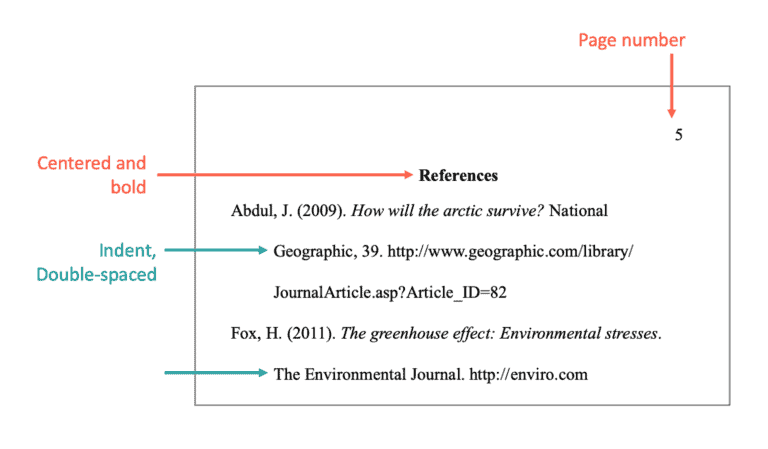
Final APA Format Checklist
Prior to submitting your paper, check to make sure you have everything you need and everything in its place:
- Did you credit all of the information and quotes you used in the body of your paper and show a matching full reference at the end of the paper? Remember, you need both! Need more information on how to credit other authors and sources? Check out our other guides, or use the EasyBib APA format generator to credit your sources quickly and easily. EasyBib.com also has more styles than just the one this page focuses on.
- Is your title page properly formatted? You may feel tempted to make the title in a larger font size or add graphics to jazz it up a bit. Keep it professional looking and make everything 12 pt size font and double spaced. Here are recommended font sizes:
-
-
- 12-pt. Times New Roman
- 11-pt. Calibri, Arial, Georgia
- 10-pt. Lucida, Sans Unicode, Computer Modern
-
-
- If you created an abstract, is it directly after the title page? Some teachers and professors do not require an abstract, so before you go ahead and include it, make sure it’s something he or she is expecting.
- Is this a professional paper or a student paper?
- Professional paper — Did you include a running head on every single page of your project?
- Student paper — Did you include page numbers in the upper right-hand corner of all your pages?
- Are all headings, as in section or chapter titles, properly formatted? If you’re not sure, check section number 9.
- Are all tables and figures aligned properly? Did you include notes and other important information directly below the table or figure? Include any information that will help the reader completely understand everything in the table or figure if it were to stand alone.
- Are abbreviations used sparingly? Did you format them properly?
- Is the entire document double spaced?
- Are all numbers formatted properly? Check section 17, which is APA writing format for numbers.
- Did you glance at the sample paper? Is your assignment structured similarly? Are all of the margins uniform?
Submitting Your APA Paper
Congratulations for making it this far! You’ve put a lot of effort into writing your paper and making sure the t’s are crossed and the i’s are dotted. If you’re planning to submit your paper for a school assignment, make sure you review your teacher or professor’s procedures.
If you’re submitting your paper to a journal, you probably need to include a cover letter.
Most cover letters ask you to include:
- The author’s contact information.
- A statement to the editor that the paper is original.
- If a similar paper exists elsewhere, notify the editor in the cover letter.
Once again, review the specific journal’s website for exact specifications for submission.
Okay, so you’re probably thinking you’re ready to hit send or print and submit your assignment. Can we offer one last suggestion? We promise it will only take a minute.
Consider running your paper through our handy dandy paper checker. It’s pretty simple.
Copy and paste or upload your paper into our checker. Within a minute, we’ll provide feedback on your spelling and grammar. If there’s a pronoun, interjection, or verb out of place, we’ll highlight it and offer suggestions for improvement. We’ll even take it a step further and point out any instances of possible plagiarism.
If it sounds too good to be true, then head on over to our innovative tool and give it a whirl. We promise you won’t be disappointed.
What is APA Format?
APA stands for the American Psychological Association. In this guide, you’ll find information related to “What is APA format?” in relation to writing and organizing your paper according to the American Psychological Association’s standards. Information on how to cite sources can be found on our APA citation page. The official American Psychological Association handbook was used as a reference for our guide and we’ve included page numbers from the manual throughout. However, this page is not associated with the association.
You’ll most likely use APA format if your paper is on a scientific topic. Many behavioral and social sciences use this organization’s standards and guidelines.
What are behavioral sciences? Behavioral sciences study human and animal behavior. They can include:
- Psychology
- Cognitive Science
- Neuroscience
What are social sciences? Social sciences focus on one specific aspect of human behavior, specifically social and cultural relationships. Social sciences can include:
- Sociology
- Anthropology
- Economics
- Political Science
- Human Geography
- Archaeology
- Linguistics
What’s New in the 7th Edition?
This citation style was created by the American Psychological Association. Its rules and guidelines can be found in the Publication Manual of the American Psychological Association. The information provided in the guide above follows the 6th edition (2009) of the manual. The 7th edition was published in 2020 and is the most recent version.
The 7th edition of the Publication Manual is in full color and includes 12 sections (compared to 8 sections in the 6th edition). In general, this new edition differentiates between professional and student papers, includes guidance with accessibility in mind, provides new examples to follow, and has updated guidelines.We’ve selected a few notable updates below, but for a full view of all of the 7th edition changes visit the style’s website linked here.
- Cover page. For student papers, the cover page should include all of the following details:
- Paper title
- Student name
- Affiliation (e.g., school, department, etc.)
- Course number and title
- Course instructor
- Due date
- Font. Recommended fonts include:
- 12-pt. Times New Roman
- 11-pt. Calibri, Arial, Georgia
- 10-pt. Lucida, Sans Unicode, Computer Modern
- Running heads. These are no longer required for student papers. When included on professional papers, do not include the words “Running head:” before the paper title/head. For example:
- 6th edition – Running head: SMARTPHONE EFFECTS ON ADOLESCENT SOCIALIZATION
- 7th edition – SMARTPHONE EFFECTS ON ADOLESCENT SOCIALIZATION
- Pronouns. “They” can be used as a gender-neutral pronoun.
- Bias-free language guidelines. There are updated and new sections on guidelines for this section. New sections address participation in research, socioeconomic status, and intersectionality.
- Spacing after sentences. Add only a single space after end punctuation.
- Tables and figures. The citing format is now streamlined so that both tables and figures should include a name and number above the table/figure, and a note underneath the table/figure.
- In-text citations. If there are 3 or more source authors, you can shorten the reference by using “eg al.” after the first name.
- 6th ed. – (Ikemoto, Richardson, Murphy, Yoshida 2016)
- 7th ed. – (Ikemoto et al., 2016)
- Citing books. The location of the publisher can be omitted. Also, e-books no longer need to mention the format (e.g., Kindle, etc.)
- Using DOIs. DOI numbers should formatted as a URL.
- Example: https://doi.org/10.1038/s42255-019-0153-5
- Using URLs. URLs no longer need to be prefaced by the words “Retrieved from.”
New citing information. There is new guidance on citing classroom or intranet resources, and oral traditions or traditional knowledge of indigenous peoples.
American Psychological Association. (2020). Publication manual of the American Psychological Association (7th ed.) (2020). American Psychological Association. https://doi.org/10.1037/0000165-000
Щоб дати відповіді на запитання до цього матеріалу та отримати бали,
будь ласка, зареєструйтеся або увійдіть як користувач.
Реєстрація
Вхід
Матеріали з розділу

Цистиноз: нове у розумінні патогенезу

Березень — місяць подолання туберкульозу: ...
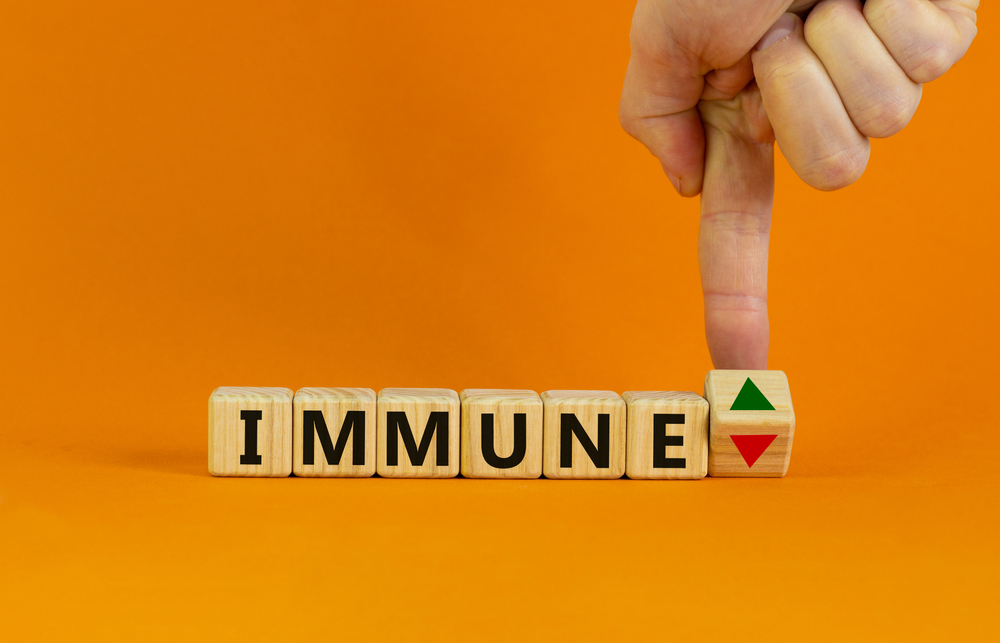
Дослідження контрольованих інфекцій людини ...
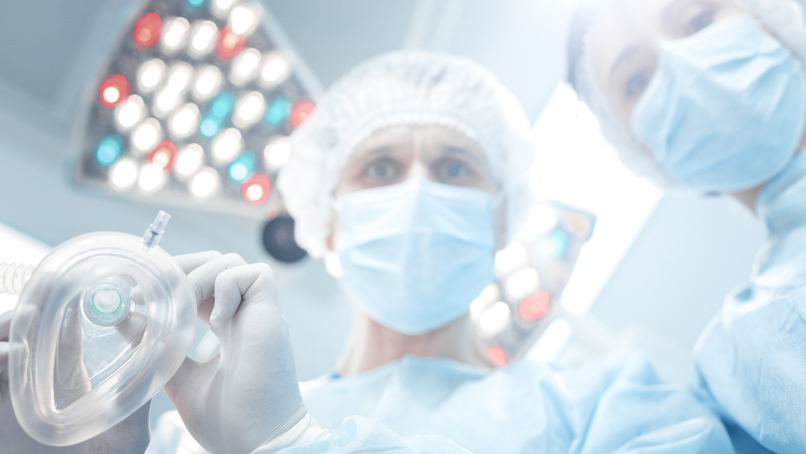
Стадії анестезії та їх ризики

Антикоагулянтна терапія при тромбозі глибо ...

Особливості перебігу хронічного гастродуод ...

